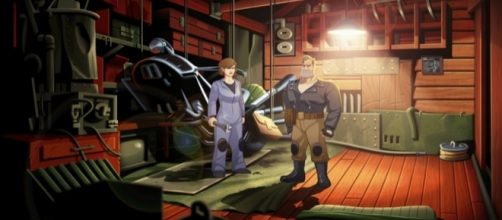After over 20 years, Tim Shafer's heavy metal graphic adventure, "Full Throttle," is finally available to modern machines. Schafer's first solo adventure at Lucas Arts, "Full Throttle" was released n 1995 to rave reviews and good sales. After the decline of the adventure game genre, this and other Lucas Arts games of its ilk were long forgotten; seemingly doomed to never see a re-release in any, way, shape, or form. But with the collaboration between Double Fine, Sony, and Disney, "Full Throttle" rides again.
Asphalt and trouble
"Full Throttle" revolves a man named Ben who is the leader of a biker gang known as the Polecats.
When the last motorcycle maker in the country, Malcolm Corley, is brutally murdered by his embezzling partner, Adrian Ripburger, the Polecats are set up to take the fall. With the authorities on his trail, Ben must go on a journey to clear his name, free his gang, and find the lost heir to Corley Motors.
As with other Schafer games, the world of "Full Throttle" is populated by great characters and is bolstered with clever dialogue and exposition. Unlike most graphic adventure games, Ben is more than just a clueless shmuck. He's tough, but he's also quiet and generally tries to avoid fights whenever possible. He's also very sly with funny comments for almost everyone and everything he comes across.
The supporting cast shines just as well, with Kath Soucie as the tough as nails mechanical genius, Maureen Corley, and Mark Hamill's gravelly voiced Adrian Ripburger.
The tune up
Whenever a remastering of a classic game comes out, there are two questions I seek to address. 1. Does the charm of the original title survive in the transition to the more updated version? 2. Does the original game still hold up? In the case of "Full Throttle Remastered," the first question can be answered with an enthusiastic yes. The new art looks great and gives a good impression of what the title would have looked like had the technology had not been so limited in 1995.
The remaster comes with bonus features such as concept art, a jukebox that features a mixture of licensed songs and original compositions, and audio commentary with the developers of the original game including Tim Schafer and Peter McConnell.
In addition, players who prefer the original game's pixels can switch between the two with a simple press of a button. All in all, this tune up was performed with care.
Does it still hold up?
For the second question, the answer is a little mixed. While the game's anarchic biker spirit mixed with Schafer's trademark humor has aged well, the arcade action sequences and obtuse puzzles, particularly in the game's uneven third act, hurt more than a chain whip. Combine that with an almost criminally short campaign, and you've got yourself one of the lesser Schafer classics. But even the roughest Schafer ride is head and shoulders over most old school adventure games.
The game features five parts. The first part is essentially a tutorial prologue which introduces the mechanics and sets up the story.
Following that, the first real act takes place in the town of Mellonweed and eases players in with that familiar adventure game charm. In the second act, puzzles become more cryptic, and things get more action focused with sloppily controlled biker fights. The third act mixes elements of the previous acts together and leads to the climactic showdown.
Yay or nay?
While not without its charms, the game feels rushed and inconsistent. This makes it hard to fully recommend to newcomers. However, fans of the original will love the extra content and updated visuals. If you haven't played this game or Schafer's other classics, I'd advise you to check out "Day of the Tentacle" or "Grim Fandango" first. However, if you loved the original and want to play it on modern machines, this is the definitive version. All in all, a marginal recommendation.

